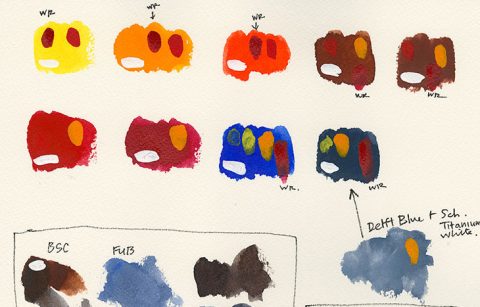Video and instructions in the full post for finishing a journal zine.
Above: A short video showing the folding, punching, sewing, and trimming of a journal zine. If you can’t see the embedded video, see the Journal Zine video on YouTube.
Participants of the Journal Zine Swap will be exchanging their journal zines at the March 21 meeting of the MCBA Visual Journal Collective. To help them as they finish up their zines I’ve posted this 7.5 minute video, showing how I folded, punched, sewed, and trimmed my zines. Participants also were sent an instruction sheet about making the zine and the various “restrictions” (e.g., in this project the goal was to be simple and straightforward so there were no 3-D inclusions; everyone had to create a zine of the same size so we could make a case for them; and so on.)
I thought that readers here at the blog might also find this short video and some notes useful for starting their own zine swap.
Next week I’ll post about the content and initial layout of the zine (there are several ways you can go about this and the topic deserves its own post). Below I have some clarifications and expanded instructions to help you with the information in the video.
• When folding your sheet butt your corners together against the fingers of your non-folding hand. You will get the feel of this with practice. It will allow you to fold accurately. Hold the corners in position with pressure as you see me do, while you use your bone folder to crease. This keeps the corners from shifting out of alignment. Also, push with your bone folder up and out, i.e., from the bottom of the fold, up and away from the page (out). This pushes the fullness out and helps keep a tidy fold. Also, don’t over use your bone folder. Stroke up to get a tidy crease. If it needs a bit more pressure, stroke down to reinforce the stated crease. Anything more than that and you’ll be shining your paper. (Folding like this is a good time to use a Teflon folder if you own one.) And finally, when you make the second fold which will be your spine, take care to hold those corners together at the fore edge so that they don’t shift out of alignment. (The fore edge is the edge of your page that is at the opening edge of the book, i.e., parallel to the spine.)
• When making a hole punching template for your zine the template needs to be as tall as the spine of your zine/pamphlet. Marking the head and tail (top and bottom) as indicated in the video is not critical if you are making a single signature pamphlet. But it always pays to get into good work habits. When working with multi-signature structures you’ll always want to know the head and tail of your template and your signatures so that the holes you punch align properly when you put them all together.
• Use thread that is three times the height of your pamphlet for this three-hole stitch. See how your first book goes. If you end up with too much left over thread then scale back for the next pamphlet. When you have a thread length that works for you and leaves you enough to knot easily, cut all your threads and set them aside. This will save you time and remeasuring.
• When you begin your sewing leave the tail end of your thread knot-less! Leave a tail of 3 to 5 inches (depending on your comfort level when working with short bits of thread to tie a knot—it’s better to waste a little bit of thread and leave longer tails then to fuss around with minute tails and an uneven and loose knot).
• Sew carefully through your holes, making sure that you do not sew through the thread when you pass through the center hole a second time. If you do you won’t be able to tighten your thread.
• Tighten your thread as you go, holding your loose tail in one hand if possible, or at least tightening that first stitch before you re-enter the center hole.
• When tightening your thread at the end of the sewing be especially careful to pull evenly and smoothly; to tighten, but not pull your holes out, or widen them. It helps to pull the thread in the direction of the spine.
• I used external knots on my zine because my prototype seemed too bulky with an internal knot. It’s just a matter of taste and on any given day, with any type of thread I might make a different decision.
• Before knotting your sewing thread at the end of the sewing procedure be sure to have one tail of thread on either side of the long stitch that goes down your spine. The knot will anchor this stitch, and it looks attractive.
• After you tie your square knot, trim your thread tails to about 1/2 inch.
• Trim only the barest amount from the top of your zine where you have folded the sheet (not the spine fold where the sewing is). We will be making a case for our zines and it is important that they are all pretty much the same height. Even without that you would want to be consistent with your trimming so that all of your zines would be of uniform height.
• It really is critical to use a lot of pressure on your ruler when trimming, because when you cut off such a small sliver (1/32 of an inch) the ruler has a tendency to slip when you don’t desire it!
• Use a fresh new blade for your cutting. Be sure to cut with, and not drag, your blade or you will find yourself tearing your zine’s top edge, typically in the outer corner.
In order to keep the video short I didn’t explain alternate methods of production. You could just as easily set up a cutting production line to cut your zine in half at the 5.5 inch point on the 11 inch side of your sheet. With all your pages cut you would then fold each half of your full sheet in half at the spine, and then collate your pages before punching and sewing as shown. You would not have to trim at the end of the process. The advantage to this approach is that you don’t have to trim at the end. The disadvantage to this approach is that you have to collate your sheets and hold them together without slippage as you punch holes and when you sew. Try it both ways and see which approach works best for you.
I’ll have more to say about journal zines next week.
REMINDER: July 18, 2011 is the sign up deadline for Collective members who want to participate in the November “Box of Journaling Bits” Exchange. Please go to the MCBA Visual Journal Collective information page and scroll down to the November 21 meeting blurb to find details about the exchange. This might be the perfect time to create your own journal zine.






















You say the Collective meeting is March 18, but by my calendar it looks like it should be March 21. I’m sure I’ll need those three extra days!
You make me want to create a collective at the book art center and Manhattan.
Melly, any group of journaling bookbinders can do this type of stuff—I thought you belonged to a group of artists who got together, but maybe those are fiber arts? Just beware, it’s a ton of work; but it is also a lot of fun.